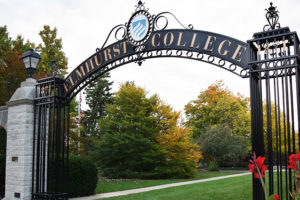
More than 65 years after the horrors of the Holocaust were unearthed during the collapse of Nazi Germany, many still ask how it could have happened.
“Seduction and delusion” played major roles in setting the stage for the Holocaust, author Erik Larson told a packed house in Hammerschmidt Memorial Chapel on April 15: History shows that Adolph Hitler seduced and deluded many inside and outside Germany who didn’t recognize his madness until it was too late.
Larson’s 2011 book, In the Garden of Beasts: Love, Terror, and an American Family in Hitler’s Berlin, tells the story of William E. Dodd, a University of Chicago history professor who was appointed U.S. ambassador to Germany in 1933, and his family as they witness the rapid transformation of Germany from a democracy to a brutal totalitarian state under Hitler.
The book focuses on Dodd, in his role as the ambassador dealing with the Nazi hierarchy, and his adventurous 24-year-old daughter Martha, who has affairs with several Nazis. Both were initially impressed by Hitler’s Germany, which was resurrecting itself from 15 years of economic depression and political chaos.
“Both were naïve in a way that the world was naïve, and in that respect they are metaphoric characters,” Larson said. “(But) in their first year in Germany, both would wake up to the true, horrific character of the Third Reich.”
Larson’s talk, and a service of remembrance for Holocaust victims, formed the keynote for the College’s 22nd annual Holocaust Education Project. More than 1,300 people attended the event, filling the balcony and even the stage behind the speaker’s lectern.
Larson said In the Garden of Beasts “is not a Holocaust book per se” but a description of the “atmosphere that allowed it to happen,” as told by people who were there.
He described Martha Dodd as a “smart, sexy” woman who was delighted by the modern and vibrant scene in Berlin and initially found the Nazis “intoxicating.” She soon began an affair with Rudolf Diels, the first head of the Gestapo. Through Diels, however, Martha began to see how even the Gestapo lived under the fear of being spied upon and imprisoned for any disloyalty.
As Martha witnesses the persecution of Jews and the loss of civil liberties for all Germans, she eventually rejects the Nazis and begins an affair with a Russian intelligence officer. Years later, their long relationship would result in her being accused of spying for the Soviets.
Her father, Larson said, at first “tried to be objective with the Nazis” and thought that in time they would “mature as leaders” and rely less on intimidation and force. Dodd himself was an “ambient anti-Semitic” who complained that he “had too many Jews on his staff” at the embassy in Berlin, Larson said, making it harder for him to gain credibility with the Germans.
While meeting with Hitler in March 1934, Dodd initially attempted to “find common ground on the ‘Jewish problem,’” Larson said, but the mere mention of Jews would send Hitler into a rage, and Hitler gave a strong hint of what was to come when he told Dodd that he would “put an end to all of them.”
Dodd was even more alarmed when he saw a draft of a proposed German law that authorized killing “incurables,” people with severe physical or mental incapacities.
Meanwhile, the State Department – the agency that advised the president on foreign affairs and the one to which Dodd reported – failed to detect what was unfolding. One reason, Larson said, was because of the depth of anti-Semitism in the U.S. at the time, including at the upper levels of the State Department.
But Dodd came to recognize the threat that Hitler posed, Larson said: “Gradually, he realized that there was no reason in the Third Reich, only pathology.”